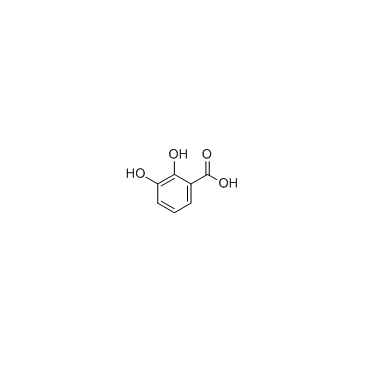2,3-Dihydroxybenzoic acid

2,3-Dihydroxybenzoic acid structure
|
Common Name | 2,3-Dihydroxybenzoic acid | ||
|---|---|---|---|---|
| CAS Number | 303-38-8 | Molecular Weight | 154.120 | |
| Density | 1.6±0.1 g/cm3 | Boiling Point | 362.5±32.0 °C at 760 mmHg | |
| Molecular Formula | C7H6O4 | Melting Point | 204-206 °C(lit.) | |
| MSDS | Chinese USA | Flash Point | 187.2±21.6 °C | |
| Symbol |

GHS07 |
Signal Word | Warning | |
|
Molecular insights into shellac film coats from different aqueous shellac salt solutions and effect on disintegration of enteric-coated soft gelatin capsules.
Int. J. Pharm. 484(1-2) , 283-91, (2015) The purpose of this investigation was to study the effect of using different salts of shellac on the disintegration properties of shellac-based enteric coatings. In the last two decades, shellac has been increasingly used as an aqueous solution for enteric co... |
|
|
Identifying chelators for metalloprotein inhibitors using a fragment-based approach.
J. Med. Chem. 54 , 591-602, (2011) Fragment-based lead design (FBLD) has been used to identify new metal-binding groups for metalloenzyme inhibitors. When screened at 1 mM, a chelator fragment library (CFL-1.1) of 96 compounds produced hit rates ranging from 29% to 43% for five matrix metallop... |
|
|
N-glycosylation profile analysis of Trastuzumab biosimilar candidates by Normal Phase Liquid Chromatography and MALDI-TOF MS approaches.
J. Proteomics 127 , 225-33, (2015) The pharmaceutical market has entered an era in which the production of new therapeutics is being often replaced by "biosimilars", copies of already commercialized products waiting for the patents to expire in order to be distributed in a more competitive and... |
|
|
Application of Electrochemiluminescence for the Evaluation of the Antioxidant Capacity of Some Phenolic Compounds Against Superoxide Anion Radicals.
Anal. Sci. 31 , 629-34, (2015) This paper for the first time reports on novel and non-enzymatic method for studying the free radical-scavenging properties of phenolic compounds against superoxide anion radicals (O2·(-)) by using the cathodic electrochemiluminescence (ECL) of lucigenin (Luc... |
|
|
Salicylic acid 3-hydroxylase regulates Arabidopsis leaf longevity by mediating salicylic acid catabolism.
Proc. Natl. Acad. Sci. U. S. A. 110(36) , 14807-12, (2013) The plant hormone salicylic acid (SA) plays critical roles in plant defense, stress responses, and senescence. Although SA biosynthesis is well understood, the pathways by which SA is catabolized remain elusive. Here we report the identification and character... |
|
|
Aromatic hydroxylation as a potential measure of hydroxyl-radical formation in vivo. Identification of hydroxylated derivatives of salicylate in human body fluids.
Biochem. J. 237(2) , 499-504, (1986) Attack by .OH radicals, generated by a Fenton system, upon salicylate produces 2,3-dihydroxybenzoate and 2,5-dihydroxybenzoate as major products and catechol as a minor product. H.p.l.c. separation combined with electrochemical detection was used to identify ... |
|
|
High-performance liquid chromatography-electrochemical determination of salicylate hydroxylation products as an in vivo marker of oxidative stress.
Anal. Biochem. 227(1) , 101-11, (1995) The in vivo measurement of highly reactive free radicals, such as hydroxyl radical (.OH), in humans is very difficult if not impossible. Specific markers are currently under investigation (amino acid hydroxylatin, protein, DNA adducts, and aromatic probes). T... |
|
|
Inhibition of 15-lipoxygenase-catalysed oxygenation of arachidonic acid by substituted benzoic acids.
Bioorg. Med. Chem. 16 , 4589-93, (2008) Elevated levels of phospholipases, prostaglandin synthases and lipoxygenases in colonic cells at various stages of malignancy indicate a strong link between dietary lipids and colon cancer. Lipoxygenase-catalysed arachidonic acid metabolism plays a key role i... |
|
|
Endoplasmic reticulum heat shock protein gp96 maintains liver homeostasis and promotes hepatocellular carcinogenesis.
J. Hepatol. 62(4) , 879-88, (2015) gp96, or grp94, is an endoplasmic reticulum (ER)-localized heat shock protein 90 paralog that acts as a protein chaperone and plays an important role for example in ER homeostasis, ER stress, Wnt and integrin signaling, and calcium homeostasis, which are vita... |
|
|
Male meiotic cytokinesis requires ceramide synthase 3-dependent sphingolipids with unique membrane anchors.
Hum. Mol. Genet. 24 , 4792-808, (2015) Somatic cell cytokinesis was shown to involve the insertion of sphingolipids (SLs) to midbodies prior to abscission. Spermatogenic midbodies transform into stable intercellular bridges (ICBs) connecting clonal daughter cells in a syncytium. This process requi... |